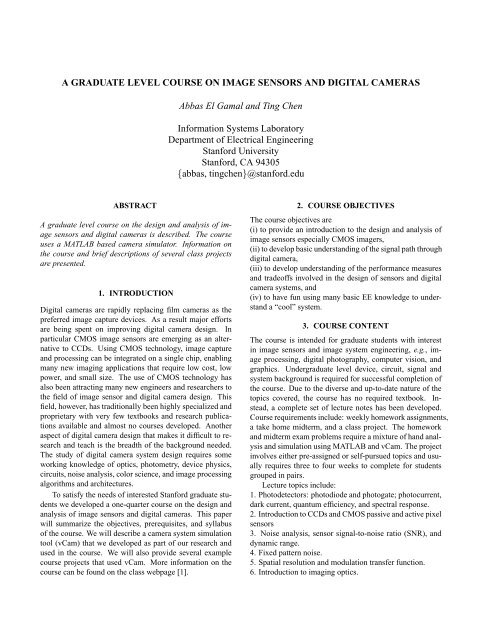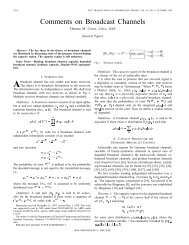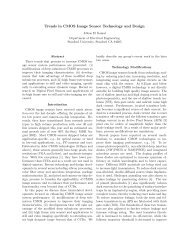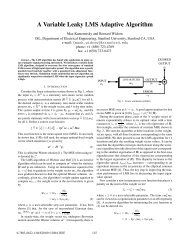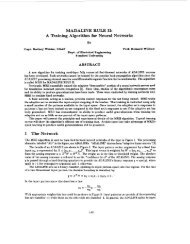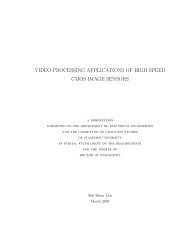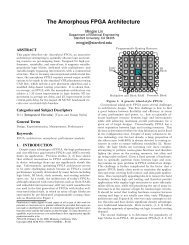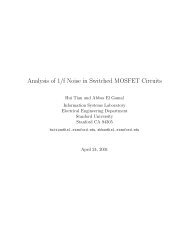A Graduate Level Course on Image Sensors and Digital Cameras
A Graduate Level Course on Image Sensors and Digital Cameras
A Graduate Level Course on Image Sensors and Digital Cameras
Create successful ePaper yourself
Turn your PDF publications into a flip-book with our unique Google optimized e-Paper software.
A GRADUATE LEVEL COURSE ON IMAGE SENSORS AND DIGITAL CAMERASAbbas El Gamal <strong>and</strong> Ting ChenInformati<strong>on</strong> Systems LaboratoryDepartment of Electrical EngineeringStanford UniversityStanford, CA 94305{abbas, tingchen}@stanford.eduABSTRACTA graduate level course <strong>on</strong> the design <strong>and</strong> analysis of imagesensors <strong>and</strong> digital cameras is described. The courseuses a MATLAB based camera simulator. Informati<strong>on</strong> <strong>on</strong>the course <strong>and</strong> brief descripti<strong>on</strong>s of several class projectsare presented.1. INTRODUCTION<strong>Digital</strong> cameras are rapidly replacing film cameras as thepreferred image capture devices. As a result major effortsare being spent <strong>on</strong> improving digital camera design. Inparticular CMOS image sensors are emerging as an alternativeto CCDs. Using CMOS technology, image capture<strong>and</strong> processing can be integrated <strong>on</strong> a single chip, enablingmany new imaging applicati<strong>on</strong>s that require low cost, lowpower, <strong>and</strong> small size. The use of CMOS technology hasalso been attracting many new engineers <strong>and</strong> researchers tothe field of image sensor <strong>and</strong> digital camera design. Thisfield, however, has traditi<strong>on</strong>ally been highly specialized <strong>and</strong>proprietary with very few textbooks <strong>and</strong> research publicati<strong>on</strong>savailable <strong>and</strong> almost no courses developed. Anotheraspect of digital camera design that makes it difficult to research<strong>and</strong> teach is the breadth of the background needed.The study of digital camera system design requires someworking knowledge of optics, photometry, device physics,circuits, noise analysis, color science, <strong>and</strong> image processingalgorithms <strong>and</strong> architectures.To satisfy the needs of interested Stanford graduate studentswe developed a <strong>on</strong>e-quarter course <strong>on</strong> the design <strong>and</strong>analysis of image sensors <strong>and</strong> digital cameras. This paperwill summarize the objectives, prerequisites, <strong>and</strong> syllabusof the course. We will describe a camera system simulati<strong>on</strong>tool (vCam) that we developed as part of our research <strong>and</strong>used in the course. We will also provide several examplecourse projects that used vCam. More informati<strong>on</strong> <strong>on</strong> thecourse can be found <strong>on</strong> the class webpage [1].2. COURSE OBJECTIVESThe course objectives are(i) to provide an introducti<strong>on</strong> to the design <strong>and</strong> analysis ofimage sensors especially CMOS imagers,(ii) to develop basic underst<strong>and</strong>ing of the signal path throughdigital camera,(iii) to develop underst<strong>and</strong>ing of the performance measures<strong>and</strong> tradeoffs involved in the design of sensors <strong>and</strong> digitalcamera systems, <strong>and</strong>(iv) to have fun using many basic EE knowledge to underst<strong>and</strong>a “cool” system.3. COURSE CONTENTThe course is intended for graduate students with interestin image sensors <strong>and</strong> image system engineering, e.g., imageprocessing, digital photography, computer visi<strong>on</strong>, <strong>and</strong>graphics. Undergraduate level device, circuit, signal <strong>and</strong>system background is required for successful completi<strong>on</strong> ofthe course. Due to the diverse <strong>and</strong> up-to-date nature of thetopics covered, the course has no required textbook. Instead,a complete set of lecture notes has been developed.<str<strong>on</strong>g>Course</str<strong>on</strong>g> requirements include: weekly homework assignments,a take home midterm, <strong>and</strong> a class project. The homework<strong>and</strong> midterm exam problems require a mixture of h<strong>and</strong> analysis<strong>and</strong> simulati<strong>on</strong> using MATLAB <strong>and</strong> vCam. The projectinvolves either pre-assigned or self-pursued topics <strong>and</strong> usuallyrequires three to four weeks to complete for studentsgrouped in pairs.Lecture topics include:1. Photodetectors: photodiode <strong>and</strong> photogate; photocurrent,dark current, quantum efficiency, <strong>and</strong> spectral resp<strong>on</strong>se.2. Introducti<strong>on</strong> to CCDs <strong>and</strong> CMOS passive <strong>and</strong> active pixelsensors3. Noise analysis, sensor signal-to-noise ratio (SNR), <strong>and</strong>dynamic range.4. Fixed pattern noise.5. Spatial resoluti<strong>on</strong> <strong>and</strong> modulati<strong>on</strong> transfer functi<strong>on</strong>.6. Introducti<strong>on</strong> to imaging optics.
7. Color Processing: color demosaicing, color correcti<strong>on</strong><strong>and</strong> white balance.8. Analysis of digital camera signal path, from the scenethrough the imaging optics, the sensor, the A/D c<strong>on</strong>verter,to the different color processing steps using vCam, a MAT-LAB based digital camera simulator.9. Recent research topics, e.g., digital pixel sensor <strong>and</strong> highdynamic range schemes.4. DIGITAL CAMERA SIMULATORA digital camera, as depicted in Figure 1, is a complex systemcomprising comp<strong>on</strong>ents that use different technologies.Given the complexity of the system, simulati<strong>on</strong> tools areneeded to study any design tradeoffs <strong>and</strong> their ultimate effects<strong>on</strong> image quality. To the best of our knowledge nosuch simulati<strong>on</strong> tools are commercially available. To adressthis need, we developed our own camera simulator (vCam).Figure 2 shows vCam’s imaging pipeline. The simulatorprovides models for the scene, the imaging optics, <strong>and</strong> thesensor. The simulator is written in MATLAB <strong>and</strong> is modularto facilitate future modificati<strong>on</strong>s <strong>and</strong> extensi<strong>on</strong>s.LensCFA<strong>Image</strong>sensorAGCADCAutoFocusAutoExposureColorProcessing<strong>Image</strong>Enhancement&Compressi<strong>on</strong>C<strong>on</strong>trol &InterfaceFig. 1. Block diagram for a typical digital camera systemstudents resulting in a number of research publicati<strong>on</strong>s. Thefollowing are brief descripti<strong>on</strong>s of the most recent projects.5.1. Pixel size studyAn important parameter in the design of an image sensoris the choice of pixel size. A small pixel size is desirablebecause it results in a smaller die size <strong>and</strong>/or higher spatialresoluti<strong>on</strong>, while a large pixel size is desirable because it resultsin higher dynamic range <strong>and</strong> signal-to-noise ratio. Weasked the students to investigate this tradeoff analytically<strong>and</strong> using vCam. This project was pursued further resultingin a c<strong>on</strong>ference paper [2].5.2. High dynamic range schemesAn important figure of merit for image sensors is dynamicrange, i.e., the range of illuminati<strong>on</strong> that can be captured ina single image. Several schemes have been proposed to enhanceCMOS image sensor dynamic range. The purposeof this project was to compare the performance of theseschemes based <strong>on</strong> SNR <strong>and</strong> image quality using vCam. Theprojects c<strong>on</strong>firmed the results of the h<strong>and</strong> analysis in [3].5.3. “H<strong>on</strong>ey Comb” pixel arrayFuji Film recently introduced a new CCD image sensor [4],which they called “H<strong>on</strong>ey Comb” CCD. The main motivati<strong>on</strong>for this structure is to enhance spatial resoluti<strong>on</strong> withoutincreasing the number of pixels or die size (cost). Thegoal of this project was to use vCam to validate (or dispute)the claimed advantage of the “H<strong>on</strong>ey Comb” array structureover the c<strong>on</strong>venti<strong>on</strong>al rectangular pixel array. The projectshave shown that for scenes with mainly vertical <strong>and</strong> horiz<strong>on</strong>talspatial structures, the “H<strong>on</strong>ey Comb” pattern is indeedbetter. No advantage was observed for other types ofscenes.6. REFERENCES[1] “Introducti<strong>on</strong> to <strong>Image</strong> <strong>Sensors</strong> <strong>and</strong> <strong>Digital</strong> <strong>Cameras</strong>,”in http://www.stanford.edu/class/ee392b.[2] T. Chen, P.B. Catrysse, A. El Gamal, <strong>and</strong> B.A. W<strong>and</strong>ell,“How small should pixel size be?,” in Proceedings ofSPIE, April 2000, vol. 3965, pp. 451–459.Fig. 2. vCam imaging pipeline5. SAMPLE COURSE PROJECTSAn important requirement for the course is the final classproject. Each year we proposed <strong>on</strong>e or two projects that thestudents did in pairs. Most projects required the studentsto use vCam as a tool for optimizing or comparing designopti<strong>on</strong>s. Several projects have been pursued further by the[3] D.X.D Yang <strong>and</strong> A. El Gamal, “Comparative analysisof SNR for image sensors with widened dynamicrange,” in Proceedings of SPIE, February 1999, vol.3650, pp. 22–28.[4] T. Yamada, Y.G. Kim, H. Wakoh, T. Toma,T. Sakamoto, K. Ogawa, <strong>and</strong> E. Okamoto, “A ProgressiveScan CCD <strong>Image</strong>r for DSC Applicati<strong>on</strong>s,” 2000IEEE ISSCC Digest of Technical Papers, vol. 43, pp.110–111, February 2000.


